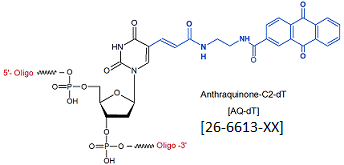
Modification : Anthraquinone-C2-dT
Catalog Reference Number
Category
Modification Code
5 Prime
3 Prime
Internal
Molecular Weight (mw)
Extinction Coeficient (ec)
Technical Info (pdf)
Absorbance MAX
Emission MAX
Absorbance EC
26-6613
Redox Electrochemical
[AQ-dT]
Y
Y
Y
1077
8.7
PS26-6613.pdf
-
-
-
| Catalog No | Scale | Price | | 26-6613-05 | 50 nmol | $1,064.00 | | 26-6613-02 | 200 nmol | $1,064.00 | | 26-6613-01 | 1 umol | $1,307.00 | | 26-6613-03 | 2 umol | $1,474.00 | | 26-6613-06 | 5 umol | $5,881.50 | | 26-6613-10 | 10 umol | $9,521.00 | | 26-6613-15 | 15 umol | $13,068.00 |
| Discounts are available for Anthraquinone-C2-dT! |
| Modification* Discount Price Structure |
|
1 site/order
|
List price
|
|
2 sites/order
|
10% discount
|
|
3 sites/order
|
20% discount
|
|
4 sites/order
|
30% discount
|
|
5-9 sites/order
|
50% discount
|
|
10+ sites/order
|
60% discount
|
|
*Exceptions apply
|
Anthraquinone-modified oligonucleotides have proven to be versatile tools in stabilization of duplex DNA by intercalation (1),electrochemical detection of single-base mismatches (SNPs)(2),and as photoexcitable probes for the study of DNA hole transport(3). Charge-transfer phenomena in DNA either through oxidativeor reductive pathways have received considerable attention in recent years due to their importance in biological environments such protein-DNA complexes, DNA damage, mutations and cancer (4).
Anthraquinones can be incorporated into oligonucleotides by using Anthraquinone-C2-dT during oligo synthesis.The anthraquinone moiety is useful for applications such as intercalation, duplex and triplex stabilization, photochemical immobilization, quenching of fluorescence, electrochemical detection, and charge transport through nucleic acids.
Anthraquinone derivatives as electron-acceptors
Anthraquinone-C2-dT CEP features an electronically insulating tether that places the anthraquinone at a significant distance from the oligonucleotide. Dialkoxy derivatives of anthraquinone (AQ), dicyano-anthraquinone (DCAQ) and tetracyanoanthraquinone (TCAQ). displayed quasireversible, two sequential one-electron transfer redox reactions. DFT calculations of DCAQ and TCAQ demonstrate structural changes upon reduction, which is supported by spectroelectrochemical experiments.
References
- H. Ihmels and D. Otto,Top. Curr. Chem., 2005,258, 161-204.
- Mikkel F. Jacobsen, Elena E. Ferapontova and Kurt V. Gothelf. Org. Biomol. Chem., 2009, 905-908.
- A. Okamoto, T. Kamei and I. Saito,J. Am. Chem. Soc., 2006,128,658-662.
- Review: H.-A. Wagenknecht,Nat. Prod. Rep., 2006,23, 973-1006 and references therein. Charge-transfer in DNA: From mechanism to Application, ed. H.-A.Wagenknecht, Wiley-VCH, Weinheim, 2005.5 E. Mayer-Enthart and H.-A. Wagenknecht,Ange.
- Ward, D.C., Reich, E., Stryer, L. Journal of Biological Chemistry, 1969, 244, 1228-1237.
- Murschell, A.E., Kan, W.H., Thangaduraia, V. and Sutherland, T.C. Phys. Chem. Chem. Phys., 2012,14, 4626-4634.
- Anthraquinone-C2-dT
|
